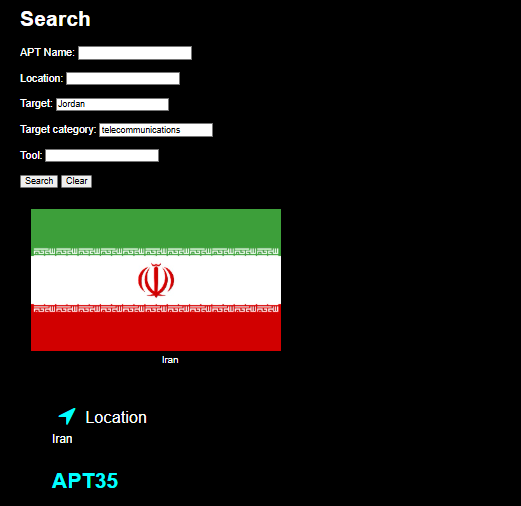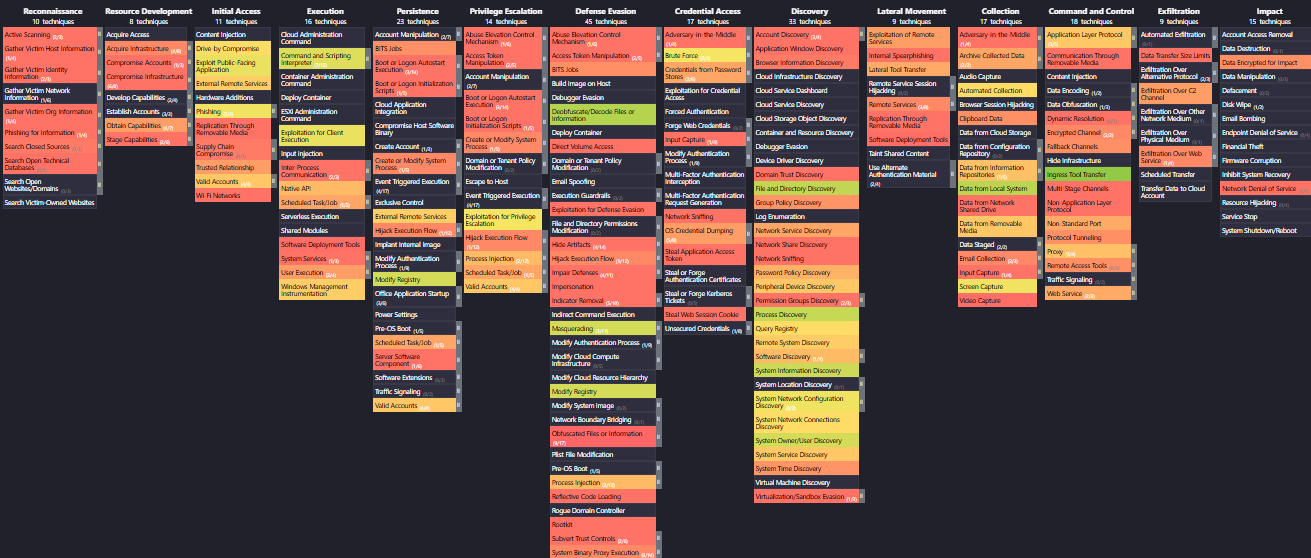Attacker Heatmap
Detection Engineer
Detection engineering is a specialized cybersecurity focused on the structured process of designing, implementing, testing and maintaining detection logic that identifies malicious activity in an environment.
To ensure these detections are well structured, teams map their detection rules to the MITRE ATT&CK. This mapping not only highlights missing techniques but also helps decide which new detections should be built first based on their relevance and potential impact.
All of this work fits within the SOC-CMM Framework, which measures a Security Operations Center’s performance through two main aspects: capability and maturity.
Capability represents the skills, tools, and processes that a SOC has in place, while maturity measures how consistent, repeatable, and optimized those processes are. Detection engineers use this framework to assess how well the SOC can detect and respond to threats.

Detection Engineering Lifecycle
detection begins by collecting and centralizing logs from endpoints, servers, networks, cloud services, and applications.
Security teams begin by identifying and prioritizing threats that matter most to their organization. They often use frameworks like MITRE ATT&CK to map out attacker techniques and understand how these behaviors might appear in their environment.
By comparing their existing detections against this framework, teams can perform a gap analysis to find where they are blind areas where attacks could go unnoticed. This process results in a clear set of prioritized detection use cases and well-defined analytic requirements focused on real attacker behavior.
Within a SOC, two main components drive this process: Use Case Management and Detection Engineering & Validation. Both are important for strong detection.
Use Case Management focuses on creating and maintaining the security scenarios that guide monitoring. This begins with Threat Profiling, where analysts identify potential threats by studying attacker behaviors.

Each use case is then mapped to security frameworks like MITRE ATT&CK or NIST to ensure standardization and better tracking. After that, Prioritization helps determine which use cases are most critical based on factors like risk, impact.
[Threat intelligence plays an important role in identifying the most relevant attackers]
Threat Profiling
We know that we are going to explain how we can make the attacker suffer and take a baby step to create a full picture of building a strong detection environment based on the attacker’s behavior.
threat profiling, which is also known as attacker heatmap, separated into:
Strategic: which is responsible for gathering information about any threat actors interested in our client
operational: which is responsible for how many of them is active and what sector intersted in.
tactical: here we are focusing on which TTPs(tactics, techniques, and procedures) are used by the attacker and giving it a score based on opertional stage(in our case, activity and sectors).
So, what is the score? That score is a priority number we use to decide which techniques to cover first when writing detection rules and playbooks, so we start with the highest-scored techniques and work down until we have reasonable coverage.
Example
Our program is focusing on the targeted jordan government and telecommunications.
We are beginning with strategic and operational as we discussed.
By Using ETDA, APTMAP and Exel sheat
We can get:
All groups targeting Jordan and targeting the sector Telecommunications and government (using ETDR)
Changed Name Country Observed APT groups
Chafer, APT 39 Iran 2014-Sep 2020 target telecommunication and government
DNSpionage Iran 2019-Apr 2019 target telecommunication and government
Earth Krahang China 2022 target telecommunication and government
Magic Hound, APT 35,
Cobalt Illusion,
Charming Kitten Iran 2012-Jun 2025 Active(target telecommunication and government)
Molerats, Extreme Jackal,
Gaza Cybergang [Gaza] 2012-Jul 2023 Active(target telecommunication and government)
MuddyWater, Seedworm,
TEMP.Zagros,
Static Kitten Iran 2017-Jul 2025 Active(target telecommunication and government)
OilRig, APT 34, Helix
Kitten, Chrysene Iran 2014-Sep 2024 Active(target telecommunication and government)
Operation HangOver,
Monsoon, Viceroy Tiger India 2010-Jan 2025 Active(target telecommunication and government)
Operation Parliament [Unknown] 2017 target telecommunication and government
Sea Turtle Turkey 2017-2021 target telecommunication and government
All groups targeting Jordan and targeting the sector Government only (using ETDR)
Changed Name Country Observed APT groups
CopyKittens,
Slayer Kitten Iran 2013-Jan 2017
Desert Falcons [Gaza] 2011-Oct 2023 Active
Gelsemium China 2014-2023 Active
Inception Framework,
Cloud Atlas Russia 2012-2024 Active
NetTraveler, APT 21,
Hammer Panda China 2004-Dec 2015
Silence, Contract Crew [Unknown] 2016-Aug 2022
Sofacy, APT 28,
Fancy Bear, Sednit Russia 2004-Apr 2025 Active
Turla, Waterbug,
Venomous Bear Russia 1996-2024 Active
Volatile Cedar Lebanon 2012-Early 2020
WIRTE Group Middle East 2018-Feb 2024 Active

All groups targeting Jordan and targeting the sector Government, and (using APTMAP)
changed name:
APT21,APT 21, APT21, HAMMER PANDA, Hammer Panda, NetTraveler, TEMP.Zhenbao (low)

All groups targeting Jordan and targeting Telecommunication and government sectors (using APTMAP)
changed name:
Active(target telecommunication and government):
APT35,APT 35, APT35, Ballistic Bobcat, COBALT MIRAGE, Charming Kitten, CharmingCypress, Cobalt Illusion, Educated Manticore, G0059, Magic Hound, Mint Sandstorm, Newscaster Team, Operation “BadBlood”, Operation “Sponsoring Access”, Operation “SpoofedScholars”, Operation “Thamar Reservoir”, Phosphorus, TA453, TEMP.Beanie, Tarh Andishan, Timberworm, TunnelVision, UNC788, Yellow Garuda,

All groups targeting Jordan and the targeting sector (using Excel Sheet)
Changed name:
target government
- Sofacy APT28 Sednit Pawn Storm Group 74 Tsar Team Fancy Bear Strontium Swallowtail SIG40 Grizzly Steppe TG-4127 SNAKEMACKEREL,Armada Collective, Dark Power, G0007, ATK5,Fighting Ursa, ITG05,Blue Athena
- AridViper Desert Falcon APT-C-23 Two-tailed Scorpion APT_C_23(low)
- BlackOasis (low)

After we gather this information can now go to the theired step, which is tectical.
For creating the heatmap, we should use MITRE., We are going to use a tool from MITRE called Attack Navigator,
based on the score we gave to the techniques from all APTs and collected all of them in one heat map, this is the final one.
